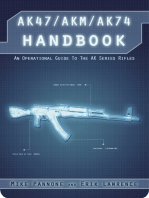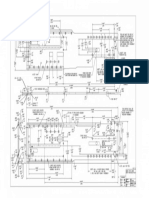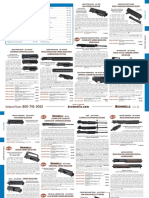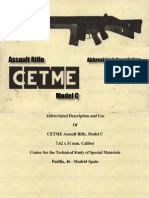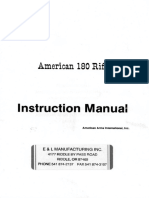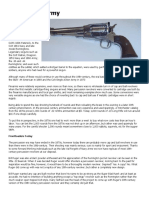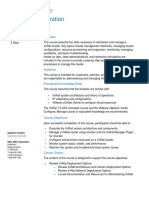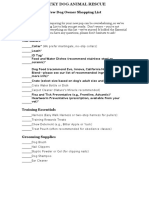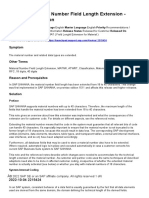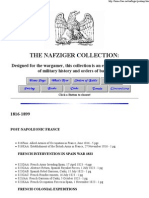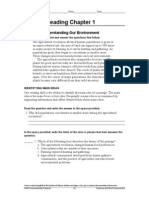Mini-14 - AC556
Mini-14 - AC556
Uploaded by
falcon62Copyright:
Available Formats
Mini-14 - AC556
Mini-14 - AC556
Uploaded by
falcon62Copyright
Available Formats
Share this document
Did you find this document useful?
Is this content inappropriate?
Copyright:
Available Formats
Mini-14 - AC556
Mini-14 - AC556
Uploaded by
falcon62Copyright:
Available Formats
Visit us on line at: www.smallarmsreview.
com
The author bought a Mini-14 soon It has been over thirty years since Sturm, Ruger, & Com-
after its introduction and immediately in-
stalled a variable 3x-to-9x optical sight. pany introduced a semiautomatic 5.56x45mm (5.56 NATO)
He still owns it and it has served him well. carbine. It looked like a small version of a US Army M14
Its five shot group accuracy, with military
ball ammunition, is on the order of 1.5
and it was, in fact, called a “Mini-14.” The Ruger carbine
inches at one hundred yards. Serious rifle- was an immediate sales success and it has been in continu-
men sneer at this degree of accuracy of ous production since its introduction.
course. Remember though, this is an out-
of-the-box semiautomatic rifle, using less-
than-the-best ammunition and it has met It had a thirteen inch barrel and a side-fold- In addition to their fire control selec-
the author’s needs for thirty-plus years. Re- ing stock. This model was called the AC- tors, full-auto Ruger carbines had flash hid-
liability-wise, nothing could have been bet- 556K.” It is assumed that the “K” in the ers that served a dual purpose. Besides the
ter than his Mini-14. When using a genu- compact version’s designation stands for obvious function of shielding muzzle flash,
ine Ruger manufactured magazine, the the German word “Kurtz,” meaning it also served as a rifle grenade launching
author has never experienced a failure with “short.” If a 13-inch barrel AC-556K is fixture. When launching a rifle grenade, a
it. placed into a standard AC-556 stock, the special type of blank cartridge is used to
A fully automatic version of the Ruger result is a very short select-fire carbine that propel the grenade.
Mini-14 was also introduced. The basic points very naturally. The safety on the full-auto AC-556
blue-steel model was called the AC-556. Before long, AC-556s became avail- Ruger carbine is ergonomically located
Another model was available that accepted able in stainless steel versions. The prefix within the trigger guard. This is the same
a standard M7 bayonet and was designated “K” was added to the designation of those location as found on the M1 Garand and
AC-556GB (“GB” for government bayo- that were made of stainless steel and thus the M14.
net). became the KAC-556 and KAC-556K if The fire control selector on the AC-
A very compact version of the AC-556 it was the short barreled version with side- 556, like the M14’s, is located above the
was soon added to the Ruger product line. folding stock. trigger on the right rear side of the receiver.
Top, the author’s thirty-year-old Ruger Mini-
14. It has not malfunctioned in thirty-plus
years. Bottom, a Ruger KAC-556GB.
18 The Small Arms Review - Vol. 7 No. 12 - September, 2004
Visit us on line at: www.smallarmsreview.com
Right: Three Ruger AC-556 fire control selectors. The top one is set to semi-
auto. The middle one is set to three-round-burst. The bottom one is set to
full-auto.
The selector has a locking button on top produce a burst of one, two or three rounds.
that assures that the AC-556 remains in the After firing the first burst in the burst mode,
user-selected mode of fire. The button must the round-counter will become properly
be pressed downward in order to reposi- synchronized. All subsequent bursts will
tion the selector. then be of three rounds unless the trigger
Unlike an M14, an AC-556 fire con- is released before the disconnector ends
trol selector has three firing modes: semi- the burst.
auto (straight up), three-round-burst (mid- At the AC-556’s relatively slow cy-
position) and full-auto (horizontal). The clic rate of 750 rounds per minute (rpm),
semi-auto and full-auto selector positions with just a little practice a shooter can set
are self explanatory. The three-round-burst the selector to full-auto and fire two, three
position needs some further discussion or four founds at will. Few experienced
though. Due to the way in which it func- AC-556 shooters use the burst position of
tions, when the burst is first selected, it the selector.
does not always produce a three-round
burst. Depending on the circumstances, the Magazines
selector can produce bursts of one, two or
three rounds on the first pull of the trigger. Genuine Ruger AC-556 magazines are
This is not generally a problem but an ex- produced in capacities of five, twenty and
planation is in order. thirty rounds. Like the detachable box
When an AC-556 is fired in either magazines of most modern rifles, AC-556
semi, burst or full-auto, a pawl engages and magazines are of the staggered column,
advances a ratcheting round-counter. left/right feeding design. They are very
When burst is selected and the round- reliable and easy to load.
counter reaches its third step, the AC-556 Other manufacturers have produced
disconnector is engaged to prevent another magazines for the AC-556. Some of these
shot. The explanation for the uncertain have proven to be just as reliable as genu-
burst becomes clear upon reflection. ine Ruger magazines. Others have been
Though the round-counter is disengaged less reliable. In the author’s experience, begins easily but it becomes difficult after
from the disconnector when either semi- magazines that were made for the AC-556 inserting approximately fifty rounds. The
auto or full-auto is selected, the round- by Ramline and Thermold have proven M.W.G. 90-round magazine seems to have
counting pawl is never disengaged from themselves to be nearly equal to genuine more internal friction than other staggered
the trigger. It counts the fired rounds in the Ruger magazines. column, left/right feeding magazines. This
semi-auto and the full-auto modes as well. Two 90-round magazines have been is evidenced by the AC-556 operating
As a result, when burst is engaged, the made for the AC-556. The one made by springs’ lack of sufficient force to reliably
round-counter could be resting on either M.W.G. is nothing more than a very long strip the first ten rounds from a fully loaded
its first, second or third step. The first pull staggered column magazine that has been M.G.W. magazine. For the first ten rounds,
of the trigger after burst is selected could twisted into a left-offset circle. Loading it the AC-556 bolt stops with a round only
Below: From left to right are: An M.W.G. 90-round drum magazine; an AK47 90-round drum that was converted prior to
the HICAP ban for use in an AC-556; a Thermold 30/40-round AC-556 magazine; A Thermold 30-round AC-556 magazine;
A clear plastic Ramline AC-556 magazine; Ruger 30, 20 and 5-round AC-556 magazines.
The Small Arms Review - Vol. 7 No. 12 - September, 2004 19
Visit us on line at: www.smallarmsreview.com
Above: Two 90-round magazines and 90-rounds of loose ammo. The AK47/AC-556 magazine is on the right and the
M.W.G. magazine is on the left.
partially pushed into its chamber. To con- cal. This causes a little unbalance but it is for long periods without stressing the
tinue firing, it is necessary to manually not a problem for a right-handed shooter. magazine spring.
push the bolt closed. During the next ten The left-side offset magazine is cradled Like the M.W.G. 90-round magazine,
rounds, occasional failures of this type and supported in the shooter’s left arm the AK47/AC-556 drum magazine has
continue to occur. No failures of the when firing in the standing-position. more internal friction than a genuine Ruger
M.W.G. magazine were experienced if only Another manufacturer made a 90- 20-round magazine. When using the
seventy rounds were loaded into it. Con- round magazine for the AC-556 by graft- AK47/AC-556 90-round drum magazine,
sidering the difficulty of loading the last ing the upper portion of a Ruger magazine the AC-556 cyclic rate is slowed to 650
twenty rounds, even if the M.G.W. maga- to an AK47-type drum magazine. The staff rpm but, unlike the M.G.W. 90-round
zine fed rounds 71-90 reliably, most shoot- portion of this magazine is centrally lo- magazine, the cyclic rate is nearly constant.
ers would probably elect to load only sev- cated causing the AC-556 to balance well. The author was unable to wind his
enty. Like the drum magazines of Suomis, AK47/AC-556 drum magazine’s operating
More evidence of the M.W.G. 90- Thompsons and PPSh41s, the ammunition spring sufficiently to permit it to fire all
round magazine’s high internal friction is in the AK47/AC-556 drum is stacked in a 90 rounds. After firing about 50 rounds,
the slower AC-556 cyclic rate while using long, circular, single column. All other AC- the AC-556 would stop with its bolt closed
it. When using a Ruger 20-round maga- 556 magazines are of the two column type. on an empty chamber. This condition in-
zine, the AC-556 cycles at 750 rounds per An AK47/AC-556 drum loads and dicates that the drum magazine’s operat-
minute (rpm). When the M.W.G. magazine functions like a Thompson drum magazine. ing spring is unable to elevate a fresh round
is loaded with seventy rounds, the initial Whereas a Suomi or a PPSh41 drum is before the fast-cycling bolt closes. When
cyclic rate is only 500 rpm. The cyclic rate wound before it is loaded, an AK47/AC- this occurs, firing can be resumed by re-
increases to 700 rpm as it fires the last 556 and a Thompson drum magazine is winding the magazine spring and recycling
thirty rounds in the M.W.G. 90-round wound after it is loaded. In theory, this is the bolt.
magazine. an advantage as a drum magazine of this
The M.W.G. magazine is asymmetri- type may be stored loaded but unwound 7.62x39mm Conversion
The semi-automatic Ruger Mini-14 is
also offered for sale in the Soviet AK47
caliber of 7.62x39mm. Supplies of this am-
munition have been plentiful and cheap.
The full automatic AC-556 is not manu-
factured in this caliber though. Can one be
converted to 7.62x39mm caliber? Yes, it
is possible but there are considerations that
make this conversion impractical.
Ruger will sell neither a 7.62x39mm
barrel nor a bolt unless they also install it
in the firearm themselves. More impor-
tantly, Ruger will not make this caliber con-
version for an AC-556 owner. For those
who are determined to have an AC-556 in
An assembled (left) and disassembled (right) gas block. 7.62x39mm, the most practical way is to
20 The Small Arms Review - Vol. 7 No. 12 - September, 2004
Visit us on line at: www.smallarmsreview.com
buy a Mini-14 in this caliber in order to
acquire the needed parts. The skills of a
competent gunsmith would be required to
Cleaning the orifices in the AC-556 gas piston with a 1/16
install the barrel.
and 1/8 inch drill bits. The small gas port bushing (upper
There is also a very practical reason
right) is cleaned with a 1/16 inch drill bit.
for not converting an AC-556 to
5.56x39mm. To avoid the complications
that were caused by the onerous provisions
of the Magnuson-Moss Act (Public Law
93-967), Ruger sells its firearms without a
written warranty. Ruger has a reputation
though for repairing all unmodified Ruger
firearms without charge. Ruger would not
repair a caliber-converted AC-556 either
gratis or for pay. Of course, the BATF
would have to be notified as well of any
changes in barrel length or caliber since
this is not a “drop-in” and easily removed
alteration. An AC-556 owner should give
all this careful consideration before mak-
ing a conversion to this caliber.
.22 Rimfire AC-556 Conversion standard AC-556 barrel. If it is ever nec- HICAP magazine ban. If the HICAP ban
essary to return the AC-556 to Ruger for is allowed to sunset, the 30-round maga-
Due to the 5.56mm NATO round’s repair, the Ceiner .22LR conversion kit can zine will once again be available. Fortu-
long range and deep penetration, extra care be removed quickly and the original 5.56 nately, the author bought his .22LR con-
must be taken when selecting a place to NATO parts reinstalled. version kit and five extra 30-round maga-
shoot. It must have a very good backstop The .22LR kit is packed in a sturdy zines long before the HICAP ban was en-
and a large unoccupied safety area located plastic storage case. It installs in the AC- acted.
behind it as well. Additionally, when com- 556 using only a 5/32 Allen wrench and The AC-556 cyclic rate with .22 CCI
pared to a pistol caliber, the 5.56mm the wrench is supplied with the kit. Mini-Mag ammunition was 1,340 rpm. At
NATO round is very loud. For these rea- Ceiner’s installation instructions are com- this fast rate of fire, the three-round burst
sons, a backyard shooting range is gener- plete and relatively simple though first time feature proved to be very useful. When fir-
ally unsuitable for the AC-556. A simple installation is a learning experience requir- ing at 25 yards (23 meters) with three-
solution is available though. ing about twenty minutes. Subsequent in- round bursts, the .22LR AC-556 was very
Jonathon Arthur Ceiner manufactures stallations take less than ten. controllable. Most of the hits were con-
and sells a .22LR conversion kit for the Ceiner’s AC-556 .22LR conversion tained within a 3.5 inch (89 mm) circle.
Ruger AC-556. With certain brands of high kit is priced reasonably at $129. Unfortu- Initially, the Ceiner .22LR conversion
velocity .22LR ammunition, it functions nately, unless the buyer is a law enforce- kit functioned very well. After about 2,000
well in all three modes of fire. Moreover, ment officer, only 10 round magazines are rounds though, stoppages began occurring.
the .22LR caliber conversion kit uses the available for it at this time due to the In nearly every stoppage, the round struck
the face of the barrel
slightly above the chamber.
These failures occurred
with all five 30-round
magazines. A thorough
cleaning was no help.
As good fortune would
have it, the author had one
Left: When reassem-
bling an AC-556, make
certain the “link
positioner assembly”
(the part with the U-
shaped notch at arrows)
is in its most vertical po-
sition. The assembly on
the right is correct.
The Small Arms Review - Vol. 7 No. 12 - September, 2004 21
Visit us on line at: www.smallarmsreview.com
A disassembled KAC-556GB
remaining 30-round .22LR magazine that necessary for the feed lips to be parallel and driving it into the chamber. When the
had never been used. It was the one that with a constant gap width. For this reason, rapidly moving bolt strikes the face of the
was originally supplied with the Ceiner avoid using pliers or a hammer to close breech, it bounces back a short distance.
.22LR kit and it had never been removed the gap. The pressure of the compressed operating
from the storage case. With this magazine, Further testing revealed that the .22LR spring restrains the bolt and quickly pushes
the .22LR AC-556 functioned again with magazine lip gap problem can be avoided it back into battery.
near perfection. entirely if the 30-round magazine is only Bolt bounce occurs in all semi-auto
A dial caliper was used to compare loaded with 25 rounds. Loading the last .22LR firearms. While it is not a problem
the one functioning magazine with the five five rounds into the magazine requires in semiautomatic fire, it is a problem in
now unreliable ones. The only major dif- considerably more effort than loading the full automatic fire. In a semi-auto, the bolt
ference between them was the gap between previous twenty-five. The extra tension, bounces out of battery and is then pushed
the new and well-used magazines’ feeding caused by the last five rounds, seems to be back into battery before the semi-auto
lips. The functioning magazine’s feeding the culprit in spreading the magazine lips. shooter can release the trigger and pull it
lip gap measured 0.17 inch (4.32 mm). The again. On a full-auto .22LR firearm though,
same measurements on the non-function- Bolt Bounce the sear releases the hammer as the bolt
ing magazines were all greater than 0.21 reaches battery. If nothing prevents the bolt
inch (5.33 mm). All .22LR semi-autos fire from an un- from bouncing back, the hammer will
The magazine follower was removed locked breech. The mass of the bolt and strike the bolt as it bounces out of battery.
before adjusting the feeding lip gap. A vice the resistance of the operating spring keep A misfire often occurs because much of
was then used to carefully close the feed- the bolt closed during the high-pressure the falling bolt’s energy is absorbed when
ing lip gaps of the unreliable magazines. portion of the firing cycle. After the bullet it strikes the out-of-battery bolt.
It was found that the well-used magazines exits the barrel, the residual gas pressure All reliable closed-bolt .22LR ma-
would function again when their lip gaps pushes the bolt rearward and compresses chine guns, except the Ceiner .22LR/AC-
were set in the range of 0.16 inch (4.1 mm) the operating spring. The compressed op- 556, have a moving anti-bounce weight lo-
and 0.20 inch (5.1 mm). erating spring then pushes the bolt forward, cated on the bolt. A microsecond after the
To achieve proper functioning, it is stripping a fresh round from the magazine bolt strikes the breech; the moving weight
strikes the bolt and absorbs the rebound-
ing bolt’s energy, thus preventing the
bounce.
There is no obvious explanation as to
why the Ceiner AC-556 .22LR conversion
kit works so well without an anti-bounce
weight. The answer may be the AC-556’s
massive coil hammer spring. It is much
stronger than the hammer spring of an
M16. The AC-556 hammer spring seems
to overcome bolt-bounce with brute force.
It appears to push the bouncing bolt back
into battery while retaining sufficient en-
ergy to crush the priming compound in the
cartridge rim.
22 The Small Arms Review - Vol. 7 No. 12 - September, 2004
Visit us on line at: www.smallarmsreview.com
A New Problem is Discovered
After shooting .22LR cartridges in an
AC-556, thoroughly clean the chamber
before firing any 5.56mm NATO rounds.
The chamber may have accumulated de-
bris that could prevent the bolt from clos-
ing properly. Firing a high-pressure
5.56mm NATO round out of battery is dan-
gerous. Cleaning the AC-556 chamber is
not difficult and an M16 chamber clean-
ing brush or a .357 pistol brush work well.
If the AC-556 .22LR kit is shot a lot,
the gas port will become blocked with va-
porized lead and unburned powder. This
blockage does not affect the .22LR kit’s
functioning as the kit does not use the AC-
556 gas system. It is self contained and
operates on the “blow back” principle.
After the author removed his .22LR
kit and reinstalled the 5.56mm NATO
parts, the AC-556 would not function un-
less he cycled the bolt like a straight-pull
bolt action rifle. Before it would function
again in semi or full-auto, it was neces-
sary to disassemble the AC-556 gas sys-
tem and clean it.
Begin by following the AC-556 owner
manual’s disassembly steps. Some Ruger
AC-556 owners may not have an owner’s
manual. Most of the AC-556s that are in
private hands came from police depart-
ments when they traded them in for newer
guns. Only rarely were the owners’ manu-
als passed along with the firearms in trade.
This is not a problem as the Ruger Corpo-
ration wants every one to know how to use
their guns safely. AC-556 owners who lack
a manual for their AC-556 can get one free. the owner’s manual, use the following in- The gas piston has two orifices. Clean
Write Ruger and politely ask for one and structions to clean the gas system. Refer the smaller one with the 1/16 inch drill bit.
enclose a copy of your Form 4. to the picture on page 5 of the owner’s Clean the larger one with a 1/8-inch drill
When beginning AC-556 disassembly, manual as it clearly shows the parts of the bit. Again, use finger power only. Just
do not overlook one very important step. gas system. scrape out the fouling.
Make certain that the selector is set to the Use a 9/64 (0.140) inch Allen wrench The gas port in the barrel is smaller
vertical, semi-auto position before disas- to remove the four cap-screws that clamp than 1/16-inch. Use an open paper clip to
sembly and do not reposition it until after the top and bottom halves of the gas block clean it.
the AC-556 is reassembled. Failing to do (MS03500) to the barrel. Watch carefully Reassemble the gas system. Avoid
so almost guarantees that the “rocker arm as the lower half is removed from the bar- over-tightening the cap screws. The threads
assembly (MA12600)” and “link rel as the small gas port bushing can be stripped. Run a cleaning rod with a
positioner assembly (MA12700)” will be (MS02500) could fall out. If it stays in its patch through the barrel to remove any
damaged. recess, gently pull it out. After it is re- fouling that was pushed into the barrel
The Ruger AC-556 manual describes the moved, the gas piston (MS03600) will while cleaning the gas port. Clean the
gas system as being, “self-cleaning with slide out of the lower half of the gas block. chamber as previously described. Finish
5.56mm NATO ammo.” For that reason, Using only finger power to turn it, reassembly per the owner manual instruc-
the operating manual does not describe clean the small gas port bushing with a 1/ tions. Before replacing the trigger group,
how to disassemble or clean the gas sys- 16-inch drill bit. Scrape away the fouling be certain that the selector is set vertically
tem. with the bit being very careful not to en- to semi-auto. Also make certain that the
After fieldstripping the AC-556 per large the orifice. vertical arm of the “link positioner assem-
The Small Arms Review - Vol. 7 No. 12 - September, 2004 23
Visit us on line at: www.smallarmsreview.com
bly” is straight up as well. yards (274 meters), the bullet’s trajectory if a round is left in the chamber, it will
will not be more than 5 inches (12.7 cm) “cook off” in ninety seconds. For these
Shooting an AC-556 above or below the line of sight between reasons, sustained full-auto fire is not rec-
the muzzle and 350 yards (320 meters). ommended in either.
The rear sight of an AC-556 is an ap- For most users of an AC-556, this is quite Firing several consecutive 30-round
erture that is adjustable for both windage sufficient. bursts of .22LR ammo will leave lead de-
and elevation. Unlike an M16 rear sight Like an M16, an AC-556 is a light- posits in the barrel but the heat that is gen-
though, an AC-556 rear sight is not a weight full-auto firearm. Neither one is erated is not sufficient to damage it. The
quickly adjustable flip-over “L” that is particularly controllable in full-auto. Both author has never heard a report of a .22LR
zeroed for two distances. Given the flat have light-weight air-cooled barrels as cartridge “cooking off” in either an AC-
shooting trajectory of the 5.56mm NATO well. More than one RKI has reported that 556 or in an M16. Safety minded shooters
round, a two-position rear sight is unnec- firing three consecutive 30-round bursts in will not tempt fate though by leaving an
essary. If an AC-556 rear sight is adjusted either firearm will permanently diminish unfired round in the chamber of either af-
so that the bullet hits dead-center at 300 its accuracy and make the barrel so hot that ter firing multiple long bursts.
24 The Small Arms Review - Vol. 7 No. 12 - September, 2004
Visit us on line at: www.smallarmsreview.com
Ruger AC-556 or Colt M16?
Which full-auto firearm will best suit
a SAR reader’s needs, a Ruger AC-556 or
a Colt M16?
An AC-556 has three minor advan-
tages over an M16 and one major one. If
long exposure to saltwater or lower cost is
a requirement, the obvious choice is the
Ruger AC-556. Stainless steel KAC-556s
are not rare and an AC-556 is generally
priced at one-half to one-third of the cost
of a Colt M16. Except for a very few Group
Industries stainless steel M16 receivers,
stainless steel is not an option for an M16.
For most users however, stainless steel is
unnecessary.
Third, the AC-556 gas system does not
blow unburned powder and other residue
of combustion into critical places in the
receiver. Due to the nature of the M16 gas
system, it will become dirtier faster than
an AC-556. An AC-556 will function
longer without cleaning than a M16. How-
ever, for non-military use, fouling accu-
mulation is seldom a problem.
Fourth, and a very useful feature, un-
like most machine guns, the AC-556 is not
readily identifiable as a machine gun. The
differences between an AC-556 and a
Mini-14 are subtle. Both lack a prominent
pistol grip and neither look like the news
media’s idea of a dreaded “assault rifle.”
This is particularly true if an optical sight
is installed. An AC-556 is a wise choice
of firearm if stealth is a requirement. An
AC-556 may be carried, without undue at-
tention, anywhere that a hunting rifle may
be taken.
Regarding accuracy, as they arrive in-
the-box, neither a Colt M16 nor a Ruger
AC-556 is a tack driver. Much more de-
velopmental work has been done on the
M16/AR-15 though than on the AC-556
to enhance accuracy. It would be much
easier to turn an M16 into a minute-of-
angle rifle than would an AC-556.
The only practical caliber conversion
that can be made to a Ruger AC-556 is to
.22LR. A reliable .22LR kit is available for
the Colt M16 as well. Due to the M16’s
easily removable upper receiver though,
many other practical caliber conversions
are available for it. These include
7.62x39mm, 9mm Parabellum, .45ACP
and .50 Action Express. Of the two full-
auto guns, the M16 is the most versatile.
Other practical considerations are
The Small Arms Review - Vol. 7 No. 12 - September, 2004 25
Visit us on line at: www.smallarmsreview.com
the M16 has no advantage over the AC-
556. An AC-556 is the cost-effective
choice.
A reliable .22LR converted AC-556
is a near ideal firearm to use when intro-
ducing novices to full-auto fun. The ammo
is cheap, there is virtually no recoil and
the sound of the shot is not intimidating. It
is pretty much guaranteed that smiles and
excitement will be generated when new-
comers are exposed to this full-auto fun
and is sufficient reason to own a Ruger AC-
556.
spare parts and accessories. Virtually no was a good enough reason in the begin- Sources
spare parts or accessories, other than opti- ning for me to buy one. I rationalized that
cal sight mounts and magazines, are avail- there was an empty space in my gun vault.
able for a Ruger AC-556. As for the Colt, There are more practical reasons Dial Calipers
few firearms have as many spare parts and though to buy an AC-556. At one-third to Dillon Precision Products, Inc.
drop-in accessories available to them as one-half the cost of an M16, an AC-556 is 8009 E. Dillon’s Way
do M16s and AR-15s. The RKIs’ general more affordable. The AC-556 is available Scottsdale, AZ 85260
consensus of opinion is this, “The Ruger in stainless steel. With Ruger and certain 480-948-8009
AC-556 is a rifle. The M16/AR-15 is a other magazines, it functions flawlessly. An
system.” AC-556 can pass for a sporting rifle and
there is a reliable .22LR kit for it. The .22LR Conversion Kits
The Author’s Opinion Ruger factory will fix an unaltered AC-556 Jonathon A. Ceiner, Inc.
if repairs are needed. 8700 Commerce St., Dept SAR
There are many good reasons to own Unless the potential owner needs the Cape Canaveral, FL 32920
a Ruger AC-556. Simply not owning one option of quick centerfire caliber changes, 321-868-2200
26 The Small Arms Review - Vol. 7 No. 12 - September, 2004
You might also like
- Instructions Jig M16 Pocket AdapterDocument4 pagesInstructions Jig M16 Pocket Adapterjay birdNo ratings yet
- Polymer80 RJ556U Build InstructionsDocument14 pagesPolymer80 RJ556U Build InstructionsAW GehrsNo ratings yet
- Ruger 10-22 Select Fire Full Auto ConversionDocument0 pagesRuger 10-22 Select Fire Full Auto Conversiongalak12001100% (3)
- Gunpower TalonDocument4 pagesGunpower Talonolhodeboi100% (1)
- The Gun Digest Book of Firearms Assembly/Disassembly Part V - ShotgunsFrom EverandThe Gun Digest Book of Firearms Assembly/Disassembly Part V - ShotgunsRating: 5 out of 5 stars5/5 (3)
- A1 To A2Document45 pagesA1 To A2leeyangseopNo ratings yet
- AR-15 Lower Assembly InstructionsDocument7 pagesAR-15 Lower Assembly Instructionsv00d00blues100% (1)
- HK 91, SR9,93,94, SP89Document3 pagesHK 91, SR9,93,94, SP89elvergonzalez1No ratings yet
- AMP Engineering PS90 Trigger InstructionsDocument2 pagesAMP Engineering PS90 Trigger InstructionsAaron PigeonNo ratings yet
- Handi Instr OneDocument9 pagesHandi Instr OnenotjustsomeoneNo ratings yet
- Bersa 380 Owners ManualDocument23 pagesBersa 380 Owners Manualglenn_allen_15No ratings yet
- PHS - 7.62mm ManualDocument2 pagesPHS - 7.62mm ManualGriffin Armament Suppressors50% (2)
- 1911 Auto Schuemann Barrels InstructionsDocument2 pages1911 Auto Schuemann Barrels InstructionsDale WadeNo ratings yet
- CMMG 22LR Conversion Kit ManualDocument12 pagesCMMG 22LR Conversion Kit ManualDerek LoGiudice0% (1)
- ESMO 2012 Cancer Chemotherapy HandbookDocument226 pagesESMO 2012 Cancer Chemotherapy HandbookHeTranDuc100% (4)
- A K ChopraDocument3 pagesA K Choprageorgescribd33100% (1)
- AR-15 Builders Resource - Version 1 (Rev. 1)Document48 pagesAR-15 Builders Resource - Version 1 (Rev. 1)blowmeasshole1911100% (1)
- Glock,: Parts Order FormDocument7 pagesGlock,: Parts Order FormDante DeAngelisNo ratings yet
- .30 (7.63) MauserDocument1 page.30 (7.63) MauserDar LuNo ratings yet
- Browning M2 Machine Gun Receiver RSP1 Blueprint TextDocument1 pageBrowning M2 Machine Gun Receiver RSP1 Blueprint TextdevoutoccamistNo ratings yet
- Ruger 10 22 Rifle Full Auto ConversionDocument22 pagesRuger 10 22 Rifle Full Auto Conversionspanky6276100% (2)
- M4-SD II CompensatorDocument2 pagesM4-SD II CompensatorGriffin Armament Suppressors100% (2)
- Soup To Nuts 2Document10 pagesSoup To Nuts 2mtang45No ratings yet
- H&R Handi Rifle ManualDocument6 pagesH&R Handi Rifle ManualSbd RancottNo ratings yet
- AR15 Parts AssemblyDocument10 pagesAR15 Parts Assemblykolas hernandez100% (1)
- Aligning A Muzzle & Mounting SuppressorDocument2 pagesAligning A Muzzle & Mounting Suppressorcarlyblack2006100% (2)
- 2010-01-02 213920 1022 WELDABLE v2Document4 pages2010-01-02 213920 1022 WELDABLE v2logostar5No ratings yet
- RSTA Muzzle Brake / Flash Suppressor Mount Installation ManualDocument2 pagesRSTA Muzzle Brake / Flash Suppressor Mount Installation ManualGriffin Armament Suppressors0% (1)
- AR-15/M16 INDEX: Orders/TechDocument93 pagesAR-15/M16 INDEX: Orders/TechStan Brittsan67% (3)
- United States Patent: (12) (10) Patent N0.: US 6,601,331 B2Document14 pagesUnited States Patent: (12) (10) Patent N0.: US 6,601,331 B2edef345No ratings yet
- Present Arms AR-15 Gunners MountDocument18 pagesPresent Arms AR-15 Gunners MountAmmoLand Shooting Sports NewsNo ratings yet
- Ruger 10-22 Sniper RiflesDocument2 pagesRuger 10-22 Sniper RiflesPlainNormalGuy250% (2)
- Silent-Sr Sound Suppressor: Instruction Manual ForDocument12 pagesSilent-Sr Sound Suppressor: Instruction Manual ForlucaNo ratings yet
- AKT020 Rivet Jaws InstructionsDocument12 pagesAKT020 Rivet Jaws InstructionsDale WadeNo ratings yet
- Fire Control Pocket With A DRODocument7 pagesFire Control Pocket With A DROterrencebelles100% (1)
- Bolt Action 1Document10 pagesBolt Action 1lucamorlandoNo ratings yet
- 208 Office/Tech:: Pistol IndexDocument26 pages208 Office/Tech:: Pistol IndexStan BrittsanNo ratings yet
- Cemte C Rifle ManualDocument46 pagesCemte C Rifle Manualholescreek100% (1)
- The M14 Conversion To The M1 Garand: Version OneDocument13 pagesThe M14 Conversion To The M1 Garand: Version Oneleleva13No ratings yet
- High Standard-MagazinesDocument3 pagesHigh Standard-MagazinesBob WilliamsNo ratings yet
- Print Page - Welrod B - A Pistols - Toward A Scratch BuildDocument58 pagesPrint Page - Welrod B - A Pistols - Toward A Scratch BuildAndrew MichaelsNo ratings yet
- The AK Short Throw TriggerDocument6 pagesThe AK Short Throw TriggerAdam Hemsley100% (1)
- Ruger 10-22 Magnum Parts ListDocument4 pagesRuger 10-22 Magnum Parts ListPlainNormalGuy250% (2)
- Pressure Air GunDocument7 pagesPressure Air GunyuehanNo ratings yet
- AR-15 Zeroing at 25 MetersDocument2 pagesAR-15 Zeroing at 25 Metersdeolexrex100% (6)
- American 180 Rifle PDFDocument25 pagesAmerican 180 Rifle PDFValeriy Zadorozhnyi100% (1)
- TEPZZ 6 - 54Z A T: European Patent ApplicationDocument30 pagesTEPZZ 6 - 54Z A T: European Patent ApplicationJin SongNo ratings yet
- K31 - Armorers ManualDocument57 pagesK31 - Armorers ManualJames TaylorNo ratings yet
- A 518298Document19 pagesA 518298browar444No ratings yet
- Building or Restoring Your Muzzleloader: Making Muzzleloaders from Kits and Damaged GunsFrom EverandBuilding or Restoring Your Muzzleloader: Making Muzzleloaders from Kits and Damaged GunsRating: 5 out of 5 stars5/5 (1)
- Hints on the Use and Handling of Firearms Generally, and the Revolver in ParticularFrom EverandHints on the Use and Handling of Firearms Generally, and the Revolver in ParticularRating: 5 out of 5 stars5/5 (1)
- Ruger Mini 14 Parts ListDocument4 pagesRuger Mini 14 Parts Listfalcon62No ratings yet
- How To Make Your Own Tracer AmmoDocument16 pagesHow To Make Your Own Tracer AmmoRWort1100% (4)
- And The Winner Is... : Ruger Mini-14 vs. The Ar-15Document4 pagesAnd The Winner Is... : Ruger Mini-14 vs. The Ar-15James McEwen100% (1)
- Mini-14 Target RifleDocument3 pagesMini-14 Target Riflefalcon62No ratings yet
- Ruger's Old Army: Guns Magazine Feb, 2004 John TaffinDocument5 pagesRuger's Old Army: Guns Magazine Feb, 2004 John Taffinfalcon62100% (1)
- 50 CalDocument14 pages50 CalPlainNormalGuy2No ratings yet
- Computer Aided Process Planning Full Seminar ReportDocument32 pagesComputer Aided Process Planning Full Seminar ReportSarath Chandran100% (7)
- Sampling and Its TypesDocument8 pagesSampling and Its TypesSadaf RasheedNo ratings yet
- Beyond Greening: Strategies For A Sustainable World: Harvard Business ReviewDocument12 pagesBeyond Greening: Strategies For A Sustainable World: Harvard Business Reviewmaneesha srinivasNo ratings yet
- Opioid Names - Generic Brand Street - It Matttrs - 8 28 17 PDFDocument2 pagesOpioid Names - Generic Brand Street - It Matttrs - 8 28 17 PDFAldrin CrutoNo ratings yet
- Vxrail Administration: Course DescriptionDocument3 pagesVxrail Administration: Course Descriptionajd CruiseNo ratings yet
- Reading Assessment RA1 1718s1Document6 pagesReading Assessment RA1 1718s1Wrik KarmakarNo ratings yet
- Physics Project On CapacitorsDocument16 pagesPhysics Project On CapacitorsIraban GuptaBasuNo ratings yet
- PNHS Revised Contingency Planning Workshop Templates v.4Document26 pagesPNHS Revised Contingency Planning Workshop Templates v.4Thess UsonNo ratings yet
- Intimation of Incorporation of A LLP (Company Update)Document3 pagesIntimation of Incorporation of A LLP (Company Update)Shyam SunderNo ratings yet
- LD New Dog Shopping ListDocument2 pagesLD New Dog Shopping ListAbdullah TheNo ratings yet
- Material Number Field Length Extension - General InformationDocument7 pagesMaterial Number Field Length Extension - General InformationRoberto CastilloNo ratings yet
- TripCare 360 Takaful FlyerDocument2 pagesTripCare 360 Takaful FlyerUstazFaizalAriffinOriginalNo ratings yet
- Man Mangement For BPRDocument11 pagesMan Mangement For BPRVarsha PandeyNo ratings yet
- 07 - Post Napoleonic 1816-1899Document8 pages07 - Post Napoleonic 1816-1899airfix1999100% (1)
- JGJHKDocument67 pagesJGJHKAdityaNo ratings yet
- Agriculture HandoutDocument6 pagesAgriculture Handoutcdavis339No ratings yet
- Complete Download A Practical Guide to Sustainable Fashion 2nd Edition Alison Gwilt PDF All ChaptersDocument65 pagesComplete Download A Practical Guide to Sustainable Fashion 2nd Edition Alison Gwilt PDF All Chapterstaliningst100% (6)
- Radmind - Command-Line Cheat SheetDocument1 pageRadmind - Command-Line Cheat SheetBill KlinetobeNo ratings yet
- Module TTLDocument5 pagesModule TTLChristian Andre FenizaNo ratings yet
- She's Mine by Gia BaileyDocument56 pagesShe's Mine by Gia BaileyManase MunkhondiaNo ratings yet
- Printable Katakana Chart PDFDocument14 pagesPrintable Katakana Chart PDFshreya100% (1)
- Chapter-I: Background of StudyDocument19 pagesChapter-I: Background of StudyGanga RamNo ratings yet
- 01-02 - RES03 - Cover Letter and Resume Template - June 2020Document3 pages01-02 - RES03 - Cover Letter and Resume Template - June 2020RFSNo ratings yet
- Aswathy AchuDocument8 pagesAswathy AchugeethaNo ratings yet
- Module Week 1 8Document78 pagesModule Week 1 8jan ray aribuaboNo ratings yet
- EDU36311A Triple Output Bench Power SupplyDocument9 pagesEDU36311A Triple Output Bench Power Supplybrian.l.gliszinskiNo ratings yet
- Yoga - Center-Heart ChakraDocument11 pagesYoga - Center-Heart Chakraadam11.huseNo ratings yet
- Technical Guidance Document For Terms of Reference (TOR) : EAD-EQ-PCE-TG-04Document15 pagesTechnical Guidance Document For Terms of Reference (TOR) : EAD-EQ-PCE-TG-04Nisa KgNo ratings yet





















